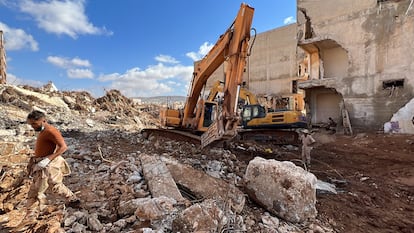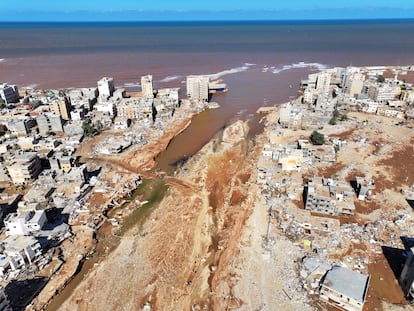Libya floods: A chronicle of a tragedy foretold
Negligence, corruption and political paralysis, together with the disastrous management of the crisis and an extreme weather phenomenon, caused a disaster unparalleled in the country’s modern history

Last Sunday at noon, when Storm Daniel was beginning to hit eastern Libya, the poet Mustafa Trabelsi, from the city of Derna, was sharing a premonitory poem titled The Rain. It read: “The rain exposes the drenched streets, the cheating contractor, and the failed state. It washes everything, bird wings and cats’ fur. Reminds the poor of their fragile roofs and ragged clothes. It awakens the valleys, shakes off their yawning dust and dry crusts. The rain a sign of goodness, a promise of help, an alarm bell.”
A few hours later, the center of Derna was completely devastated. The intense rains and stormy weather that night broke two dams built in the course of a river that runs through a valley behind the city, releasing enormous volumes of water. A quarter of the city was swept. The tragedy has killed more than 11,000 people. Trabelsi, the poet, is said to be among the victims. The final death toll is feared to rise to 20,000, as search teams continue to comb the area where some 10,000 people remain missing and nearly 40,000 are displaced.
Now that the magnitude of the tragedy is becoming clearer, Libyans are beginning to express their anger at what they believe was to blame for the disaster. For many, the mix of division and political paralysis, corruption and negligence — due, in part, to the fact that the country is controlled by two rival governments — was just as much to blame as Storm Daniel for one of the worst tragedies to hit the region.
“What has happened is, in many ways, the worst possible scenario,” says Jalel Harchaoui, an expert in Libya at the Royal United Services Institute (RUSI), based in London. “It is a juxtaposition of different dimensions that have combined and produced an apocalyptic scale [disaster] of global [resonance].”
Decades of neglect
The dams in the Libyan city of Derna were built by a Yugoslavian construction company in the 1970s as part of an infrastructure development plan promoted by Colonel Muammar Gaddafi, who had seized power in Libya through a coup d’état in 1969. After they were built, however, many analysts agree that they fell into neglect under his regime. This state of negligence continued after his overthrow and assassination during the 2011 popular revolution supported by NATO.
Evidence of this neglect has emerged in recent days. In 2007, the Turkish construction company Arsel began a project to rehabilitate the two Derna dams and build another one. And although on the Arsel website the project appears to have been completed in 2012, when the country was plunged into instability, the reality is that the work was never done. A decade later, in 2021, the Libyan Audit Office published a report noting that almost €2.3 million had been allocated to the Ministry of Water Resources for the maintenance and rehabilitation of the same dams. But this work was not carried out either.
Political divisions
Harchaoui believes that worrying about and allocating human and financial resources for the maintenance of dams that, in principle, were working, was unlikely to happen in a country marred by political divisions and with a culture deeply rooted in the military dictatorship. And this poses a long-term problem. Harchaui argues that if there were a tradition among the Libyan authorities of caring about the maintenance of national infrastructure, that would create human resources (engineers, experience, etc.) and institutionalize procedures that would help detect problems — such as the risks posed by the dams — and act to stop them. “But since that tradition does not exist,” explains the analyst, “nor does all the human and institutional structure that would come with it exist.”
The dangers of that inaction were well known. In 2022, Libyan hydrologist Abdelwanees Ashoor published a study warning that the Derna Valley had “a high potential for flood risk.” And that, for this reason, the dams in the river basin “needed periodic maintenance.”
What’s more, Derna was particularly vulnerable to a disaster of this kind. Once known for being the birthplace of artists and writers, in 2011, the city became more famous for its resistance to Gaddafi. And in 2014, it made headlines after it was occupied by the Islamic State, who were forced out a year later by an alliance of Islamist militia and ex-officers.
The city then opposed Khalifa Hafter, a marshal of the so-called Libyan National Army (LNA), which militarily controls the east of Libya. Hafter responded with a brutal bombing campaign until it was subjugated to his iron fist. “Hafter authorities launched a war against Derna, imposed a siege, carried out a very destructive urban war in 2018-2019, which made very little distinction between civilians and combatants. So the context of Derna is unique,” notes Harchaoui.
Countdown
It was in this context that eastern Libya was hit by Storm Daniel. Local authorities, emergency services and the population were aware of the risks. But the measures and instructions that were adopted before the disaster, and even while it was taking place, proved deadly.
The World Meteorological Organization (WMO) said that alerts about the danger of the storm were issued 72 hours in advance, and that the Libyan authorities were urged to take extreme precautions. On Saturday afternoon, a day before the tragedy, a local space science federation warned the storm could break the Derna dams.
Authorities in eastern Libya, led by the LNA, formed a crisis cabinet, made up almost entirely with officials from Benghazi, the region’s main city, and headed by figures with little or no experience. Almost all the warnings referred to Benghazi, 186 miles (300 kilometers) from Derna, while the rest of the area received hardly any attention. The instructions were confusing and unspecific, and the final directive — in the case of Derna — was to evacuate the areas adjacent to the coast and decree a curfew until further notice, as urged by the city council on social media.
According to witnesses in Derna, even early on Monday, about 10 minutes after the explosion that caused the dam to break was heard, the city’s authorities continued to urge the population to remain inside their houses. “They were ordered to stay, and this was coming from the army. We have a long history of war, seige, repression, which has been violent. So, if the army tells you to stay home, what you are going to do is basically be afraid to go out,” says Harchaoui.
In its next message, shortly after midday on Monday, the city council acknowledged that the situation was catastrophic and called for urgent international intervention. The director of the WMO, Petteri Taalas, said Thursday that “most of the human casualties” could have been avoided with the right warnings and instructions.
In addition to the political factors that contributed to the Derna disaster, Harchaoui points out that it is equally important to frame it within the context of a very violent storm that many link to the effects of climate change. “An exogenous event occurred in Libya that has nothing to do with the Libyans and which in itself is very unusual and must be recognized as such,” he concludes.
Sign up for our weekly newsletter to get more English-language news coverage from EL PAÍS USA Edition
Tu suscripción se está usando en otro dispositivo
¿Quieres añadir otro usuario a tu suscripción?
Si continúas leyendo en este dispositivo, no se podrá leer en el otro.
FlechaTu suscripción se está usando en otro dispositivo y solo puedes acceder a EL PAÍS desde un dispositivo a la vez.
Si quieres compartir tu cuenta, cambia tu suscripción a la modalidad Premium, así podrás añadir otro usuario. Cada uno accederá con su propia cuenta de email, lo que os permitirá personalizar vuestra experiencia en EL PAÍS.
¿Tienes una suscripción de empresa? Accede aquí para contratar más cuentas.
En el caso de no saber quién está usando tu cuenta, te recomendamos cambiar tu contraseña aquí.
Si decides continuar compartiendo tu cuenta, este mensaje se mostrará en tu dispositivo y en el de la otra persona que está usando tu cuenta de forma indefinida, afectando a tu experiencia de lectura. Puedes consultar aquí los términos y condiciones de la suscripción digital.
More information
Archived In
Últimas noticias
Welcome to the post-religion era: The idea of Christianity as the absolute truth has become obsolete
‘I thought you would like it’: The risky sexual practice popularized by TV shows and TikTok
The digitalization of tourism: ‘They promise experiences and gave us the worst possible one’
Mexican peso defies uncertainty with forecasts of a new period of stability in 2026
Most viewed
- Sinaloa Cartel war is taking its toll on Los Chapitos
- Oona Chaplin: ‘I told James Cameron that I was living in a treehouse and starting a permaculture project with a friend’
- Reinhard Genzel, Nobel laureate in physics: ‘One-minute videos will never give you the truth’
- Why the price of coffee has skyrocketed: from Brazilian plantations to specialty coffee houses
- Silver prices are going crazy: This is what’s fueling the rally











































